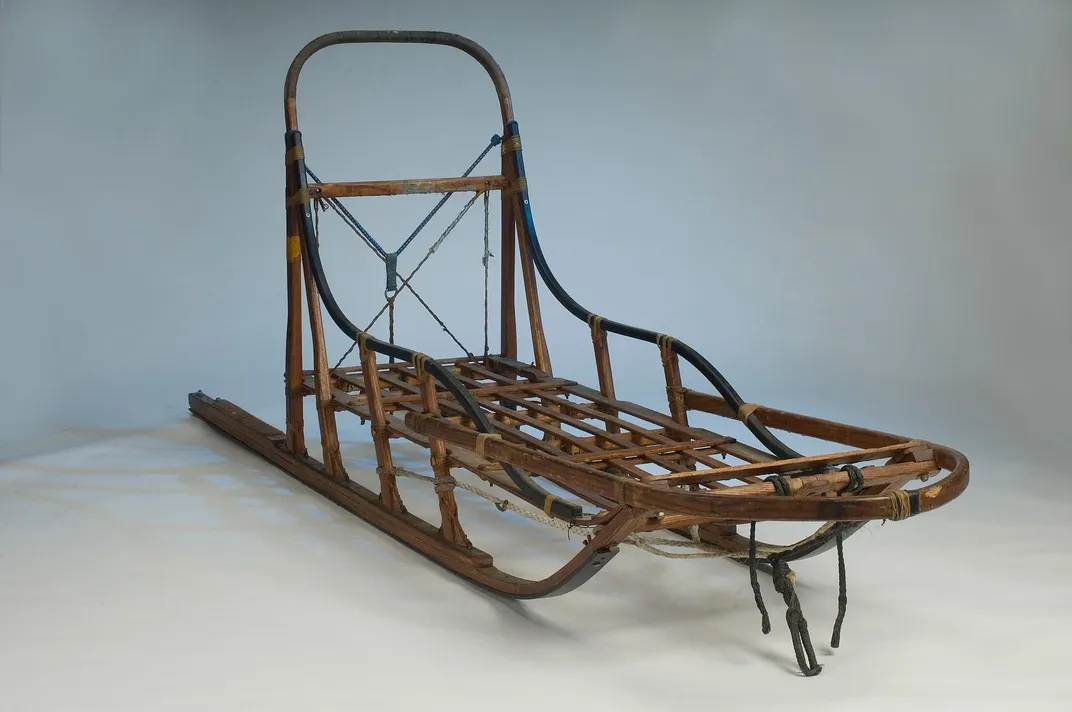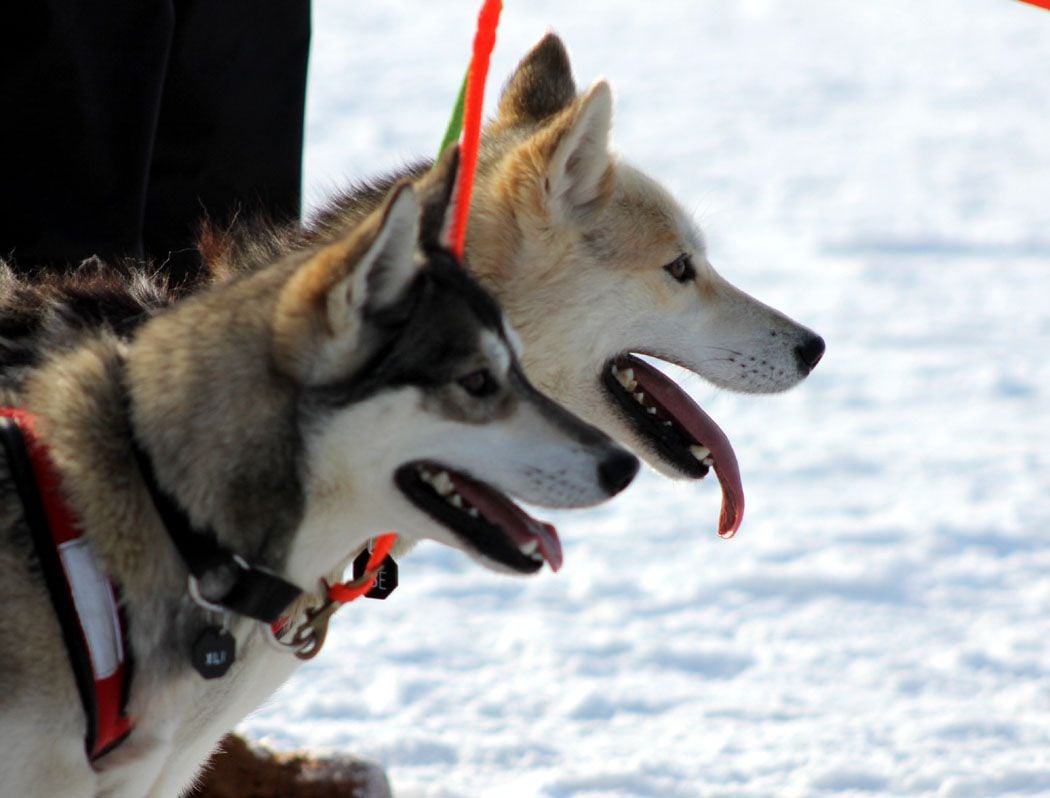Facing Blizzards and Accidents, Iditarod’s First Woman Champion Libby Riddles Persisted
A sled in the Smithsonian collections marks the historic race
/https://tf-cmsv2-smithsonianmag-media.s3.amazonaws.com/filer/d3/86/d386da39-e557-4e43-b5bc-25f46aa16de5/finishline.jpg)
Libby Riddles thought she was off to a bad start. Tossed from her sled and flying through the air in the first hour of the 1985 Iditarod Trail Sled Dog Race, it wasn’t looking good. Her dogs had taken a wrong turn, slamming her sled into discarded washing machine parts and ejecting her into mid-air. When she banged into the ground, her rampaging canine teammates dragged her face-down through the snow.
The Iditarod race was created in 1973 to celebrate the dog sled culture that tamed the Alaskan frontiers. The dogs provide the muscle in this competition, but the mushers who drive them are the strategists who pave the road to victory. The dogs “didn’t know about the $50,000 at the end of the trail or the personal satisfactions I might gain,” Riddles wrote in her account of the race. “They performed their duties just to please me. They were the real heroes of the race.” She later said that all of the dogs “have different mental and emotional skills. I have to figure out how to make each dog reach its best potential.”
Despite spills, blizzards and biting cold, Riddles would not abandon her determination to win the grueling 1,100-plus-mile Anchorage-to-Nome competition, and 18 days later, she and her dogs crossed the finish line, making her the first woman to claim victory in Alaska’s historic race.

To do it, over the course of the race, Riddles battled dehydration and fatigue, illnesses among her dogs, treacherous ground conditions and trails that were difficult to follow. “I got into every kind of disaster out there with the dogs and it was just great,” she has said. From beginning to end, her obstacles were many:
- Once, after breaking free from the spot where she had tied them during a break, her dogs hijacked her sled. The renegade runaways fled, forcing her to hitch a ride with a competitor. Eventually, she found the overzealous racers tied up by a good Samaritan and waiting for her.
- On a nasty turn, her sled toppled. She again slid face-down through the frosty precipitation until she managed to stop her dogs.
- While dozing as the sled sped through the forest at night, a limb struck both her face and her headlight. To her relief, the headlight came back on, but blood gushed from her nose.
- In a snowstorm, she spent one night alone on the trail. Despite the bone-chilling cold, she had to remove all of her wet clothes and don dry ones—a necessary step to avoid freezing to death while she slept. When she awoke in the morning, she found that her sleeping bag zipper had frozen shut. Fortunately, she was able to work it loose.
- One day, the wind alone upended her sled.
- Even in the last 24 hours of the race, she experienced a sobering realization. She was intersecting with her own tracks because her dogs were pulling her in a circle instead of forward toward the finish line. A musher and his or her lead dogs can follow remnants of trails left behind by those in the lead, but when she was alone heading toward victory, there were no tracks to follow and snow camouflaged signs that marked the trail.
Nevertheless, Riddles persevered. Her trek lasted 18 days, 20 minutes and seven seconds. It was the third Iditarod for the 28-year-old. She and her other competitors traveled through dense forest, up and down rugged mountain ranges, near devilish cliffs, across frozen rivers and lakes, through bleak and lonely tundra and along the windy coastline.
At the Smithsonian’s National Museum of American History, one of the sleds she used for her historic first is now part of the collections. It is a wooden sled made by the North Star Sled Company. But it’s the canine athletes that are most impressive says curator Jane Rogers, who has attended two Iditarod races. “This is their job, and they love to do this. I’ve been up there and witnessed that they just—it’s like they can’t be contained. As soon as they get hooked up to those harnesses they want to run.”
During the race, competitors are required to make a certain number of stops, and at each checkpoint, they must prove that their sleds have all of the equipment required by the rules of the race. Necessary cargo includes an axe, an Arctic sleeping bag, a day’s food supply for the musher, snowshoes, dog booties and even a cache of “trail mail” to commemorate the dogsleds’ one-time job as mail carriers. A fully loaded sled weighs 300 to 500 pounds. Racers are not allowed to carry cell phones, although “they do have tracking devices on the sleds,” says Rogers.

The 1985 Iditarod was atypical. Bad weather forced race officials to stop the competition twice because it was impossible for aircraft to deliver the dogs’ food to more distant checkpoints. Consequently, mushers had to huddle together at checkpoints, seek out the homes of gracious backwoods friends, or remain in the cold. While the race was on, Riddles avoided encounters with wolves and moose. Susan Butcher, favored to win that year, had to withdraw after a moose attack that killed two of her dogs. (Butcher won the next race in 1986 and then again in ’87, ’88 and in 1990.)
There are two starts for the race—a mostly ceremonial launch in Anchorage and the one where the real race begins, which is farther inland. The true competition traditionally begins at Willow, although Rogers reports that a lack of snow has pushed the actual start farther and farther north.
In 1985, there were 64 competitors, each with 14 to 18 dogs. A mushers’ biggest challenge is putting together a winning lineup of dogs. Over the course of the race, Riddles cut two problematic dogs from her team, but they were placed in safe hands at checkpoints. Mushers often leave injured or sick dogs at checkpoints. On the trail, Rogers says, “If they know the dog’s struggling, they’ll put the dog in the sled with them.” Canine participants are malamutes, Siberian huskies and the generic mixed-breed husky.
It has been estimated that mushers, who endure difficult physical labor in sub-freezing temperatures, require 6,500 calories per day instead of the 2,000 to 3,000 calories typically recommended for adults. For Iditarod racers and for their dogs, a temperature of 10 to 20 degrees is considered warm, and temperatures of 50 to 60 degrees below zero, which Riddles faced, are not extraordinary.
Riddles encountered so many snags on her way to Nome that she didn’t fully absorb the reality that she had taken the lead until she reached the Eagle Island checkpoint on the Yukon River, where the “checker” was surprised that the first knock on his door came from a woman. At most stops she slept just an hour before rejoining the race. At the race’s end, with a huge crowd at the finish line, the celebration seemed surreal after 18 days spent mostly in solitude with her dogs. She had answered the call of the wild in a performance that was both gutsy and goodhearted.
Thousands of fans watch the race each year, but some animal rights advocates claim it puts too much strain on the dogs. They report that at least 114 dogs have died over the first 30 years of the race. The Anchorage Daily News reported that 14 dogs lost their lives between 2009 and 2017.
Rogers says smart mushers appreciate their dogs and “are not going to put them in jeopardy just so they can win a race. I mean obviously, a healthy dog wins the race quicker than an unhealthy one.” Libby Riddles’ record endorses this conclusion: She won the race and the humanitarian award for keeping her dogs in top-notch condition by taking time to give them plenty of rest breaks and food.
Iditarod 2020 is under way now. It began March 8 with 57 competitors, about one-fourth of whom are women. In sharp contrast to Riddles’ experience, every winner in the last ten years has crossed the finish line on the ninth or tenth day of the race. Rogers says modern technology and aircraft have made it easier to run the race. “They’ve just got it down.” Furthermore, because of skillful breeding, “Their dogs are sleeker and they’re able to run longer and harder and faster.” Through genetics, past champions play a role in today’s races.
Riddles, who was born in Wisconsin and moved to Alaska in 1972, lived outside Nome in 1985. Used to roughing it, she wrote in her race memoir that she had not yet been able to afford a house in Alaska with running water. In 1985, she received the Women’s Sports Foundation’s designation as Sports Woman of the Year. She raced for about 20 years and then turned her attention to breeding and training dogs. Her website reports that she currently has 28 sled dogs and is a speaker on Princess Cruises’ Alaskan voyages. The first victory by a woman remains an important moment in Iditarod history.
/https://tf-cmsv2-smithsonianmag-media.s3.amazonaws.com/accounts/headshot/Alice_George_final_web_thumbnail.png)


/https://tf-cmsv2-smithsonianmag-media.s3.amazonaws.com/accounts/headshot/Alice_George_final_web_thumbnail.png)